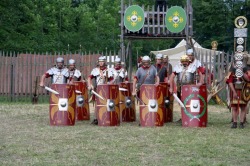Legion of the 4th Century

The Romans, after betraying the Phalanx, formed a new style of combat in which they formed three lines. The hastati formed the front of the line. The hastati were like spear men from the earlier mentioned second class. The younger soldiers were apart of the hastati and they carried on them body armor and a rectangular shield called the scutum. The hastati also carried a sword and javelins. Then alongside with the hastati in the front row were the leves, who carried just a spear and some javelins.
In the second line, there were the principes, who like the ancient first class, were the most armed soldiers in the legion. The men that made up the principes were men that had experience and were not as young as the hastati, but were more mature. Then the main group in the third line was the triarri. The triarri were the veterans of the group. So together the principes and the triarri formed the heavy infantry, the big hitters.
Then the rest of the third line contained the rorarii, and accensi. These were men of the old third and fourth classes. The rorarii were very young and very inexperienced, while the accensi were just not dependable fighters at all. That must be the reason for them being in the back of the line.
In a full legion the total number of men would consist of:
15 hastati maniples = 900 men (60 men in a maniple).
15 groups of leves = 300 men (20 men in a group).
15 principes maniples = 900 men
45 triarri, rararii, and accensi maniples = 2700 men
Total legion number = 4800
The early legion attacked in a 'one at a time' fashion. The hastati, being in the first row, would obviously make the first attack against the enemy. If the hastati were receiving a thorough punishment from the opposing side, they would fall back and lay in the security of the heavy infantry of the principes. The hastati could make counter attacks once they regrouped. Then if the principes were pushed back, the triarri, who were just a few feet behind the principes, ready for action, would charge ahead at the enemy with spears, giving a surprise to the enemy, because the idea was to make the enemy feel as though the Roman Army was almost defeated. The triarri were referred to as the last resort. The triarri would engage the enemy and fight them until the other soldiers could escape from the scene. The Roman saying was, "It has come to the triarii," which meant something was desperate.
The armor of the Roman soldiers changed as well during this time. Instead of using a bronze helmet, which was ineffective against the long swords wielded against them, they used a polished iron helmet. The scutum, which was mentioned earlier, was also introduced at this time as the large rectangular shield that it was.
By the third century, the Roman Army was considered a formidable foe to King Pyrrhus of Epirus, with his Macedonian phalanx and war elephants. Pyrrhus trained under Alexander, and was therefore very tact in his battle decisions. And even though the Romans did not defeat Pyrrhus, but was more the other way around, they put up a good fight, to be called worthy opponents of that powerful army.
The first war against Carthage was fought in the third century as well, which gave Rome more experience on the battlefield. Then later on in the same century, the Roman Army finally defeated the Gauls who launched another attack from the Po valley. This defensive success proved that the Romans were more superior than ever before now that they could defend themselves against an opponent that robbed their capital.
By the end of the Second Punic War, Rome possessed the largest and grandest army of the Mediterranean. Rome's Army included six legions made of 32,000 men and 1,600 cavalry, along with 30,000 allied infantry and 2,000 allied cavalry. If Rome wished to have all of its allies fight for itself, then there would be an extra 340,000 infantry and 37,000 cavalry at its disposal.